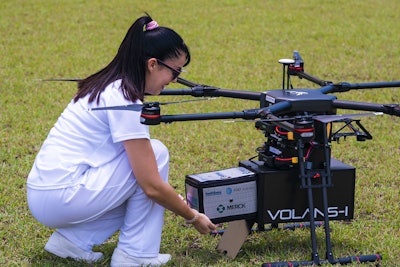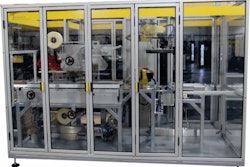Merck is committed to “being the premier, research-intensive biopharmaceutical company,” delivering its medicines, vaccines, and animal health products worldwide. Whether for the treatment of diabetes, infectious diseases, oncology, or other vaccines, these medicines need to get to patients around the globe, sometimes in remote areas.
From Aug. 20-24, Kenilworth, NJ-based Merck took part in a “Proof of Concept” project with AT&T and Softbox to test connected medical payloads carried by drones. The goal? Safely deliver temperature-sensitive medicines using drones across Puerto Rico, which continues to recover from devastating hurricanes.
An LTE-connected drone carrying Softbox’s thermal-insulated packaging system “Skypod,” which includes a smartbox powered by AT&T’s Internet of Things (IoT) technology, successfully completed demonstration flights. The field trial took place in locations across Puerto Rico, with U.K.-based Softbox providing temperature-control packaging.
"Merck is pleased to collaborate on this innovative new model for delivering medicines to patients in areas affected by natural disasters," says Brenda Colatrella, Executive Director, Corporate Responsibility at Merck. "We're proud of our long history of expanding access to our medicines and vaccines and collaborating to provide humanitarian assistance. The drone test flights give us hope that we will be able to provide a reliable supply of our medicines for disaster."
For the test flights, Merck shipped a mix of inhalers, tablets, and liquid-filled vials, in weights from 250 g to 500g. Products selected were those considered most necessary for disaster relief. Specifically, these included M-M-R II and Pneumovax 23 vaccines, anti-asthma aerosols Dulera and Proventil, anti-hypertension medicine Cozaar, and insulin, the latter of which required “cold chain” conditions. Merck donated the products to Direct Relief. Products were held at local San Juan distributor Cardinal Health, where they were picked up for each drone delivery test flight.
AT&T’s IoT technology tracks the Skypod with data viewed on a web and mobile app dashboard. The data includes near-real time external and internal temperatures of the box and its location. Light exposure data helps signal if there is box tampering during daylight, by determining if the box is open or closed.
The dashboard app will flash alerts to help drive appropriate action. For example, it will send an alert if there is a change to the temperature range of 2°C to 8°C. It will also send an alert if the drone goes outside of defined geofencing parameters.
AT&T and Softbox have adapted the Skypod from a connected flask prototype developed in the AT&T Foundry, which they showcased earlier this year. The AT&T Foundry is a network of innovation centers that collaborates with startups, technology providers and enterprises to move ideas to market faster through rapid prototyping. It moved the IoT sensors that track temperature and location from the lid of the original prototype and fit them into the smartbox.
“We’re proud to be working with AT&T in this dynamic, industry-first trial. The connected Skypod could be rapidly deployed globally in times of humanitarian disaster relief,” says Softbox Technical Director Richard Wood.
The connection that makes it possible
The AT&T Global SIM and AT&T Control Center connect and manage the Skypod’s sensor data transmission. The web and mobile app reporting dashboard use the AT&T Asset Management Operations Center.
The drone is also connected to the AT&T network, providing a communications path for flight plan and telemetry data between the drone and ground control system.
Last year, AT&T deployed the helicopter Flying COW (Cell on Wings, cell site on a drone) in Puerto Rico following Hurricane Maria. It reportedly was the first time a drone had been used to connect residents with their mobile phone services after a disaster.
“With the 2018 hurricane season upon us, we are thinking about the devastation caused by Hurricane Maria last year. This trial is a fantastic example of ‘IoT for Good,’ showcasing that it’s possible for connected medical drones to deliver vital medicines to people in times of disaster,” says AT&T Region President for Europe, the Middle East and Africa, John Vladimir Slamecka.
Further Proof of Concept projects are reportedly being arranged, but no specific details were available.
Watch a video of drone Skypod delivering vital medicine in the Puerto Rico crisis.






















